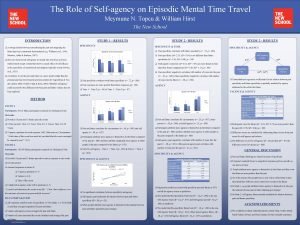The Episodic Challenges of Living with a Mental













- Slides: 13

The Episodic Challenges of Living with a Mental Illness Presented by Dave Gallson Richard Chenier National Program Director Managing Partner National Network for Mental Health Chenier Consulting Canada

Mental Health Facts: • In less than 20 years depression will be the secondleading cause of disability in the world. (World Health Organization) • Statistics Canada survey released in September 2003 is that 2. 6 million people live with mental health disorders • 450 million people worldwide are affected by mental, neurological or behavioral problems at any time. (World Health Organization) • In 1998, Health Canada conservatively estimated that the economic burden of mental health problems was $14. 4 billion a year. More recent calculations, which include indirect costs, suggest that upwards of $30 billion is lost to the Canadian economy annually due to mental health and addiction problems (Scientific Advisory Committee to the Global Business and Economic Roundtable on Addiction and Mental Health. (2002))

Mental Health Facts: • Three million (est. ) Canadians suffer from depression. Only 187, 500 (est. ) are both diagnosed and properly treated. That’s slightly more than six per cent. (“Depression At Work” The Unheralded Business Crisis In Canada - Global Business And Economic Roundtable On Addiction And Mental Health (July 2000)) • 20% of Canadians will personally experience a mental illness in their lifetime. Wilkerson (2000) (2001) (2002) • Many mental health issues are episodic. Symptoms may appear periodically, and with little advance notice.

Workplace Mental Health Facts: • Disability represents anywhere from 4% to 12% of payroll costs in Canada; mental health claims (especially depression) have overtaken cardiovascular disease as the fastest growing category of disability costs in Canada (Wilson, M. , Joffe, R. , & Wilkerson, B. (2002) • Stress, burnout and physical or mental health issues are the main issues limiting productivity in Canada, Canadian CEOs say (Productivity Through Health: A FGIworld CEO Study on Health and Productivity in Canadian Industry. (2005) • Depression is distributed within the Canadian labor force of 14 million at a 10 per cent rate, meaning about 1. 4 million working Canadians have the disease. (“Depression At Work” The Unheralded Business Crisis In Canada - Global Business And Economic Roundtable On Addiction And Mental Health (July 2000))

Implications of Employment “ Employment, or engaging in some form of meaningful work/ activity, is well recognized as a key determinant of health and essential to mental health. Conversely, unemployment has a negative effect on mental health. We know that unemployment is the leading cause of poverty, and that poverty is a leading cause of poor physical and mental health. Therefore, meaningful work and employment must be viewed as essential components to establishing and maintaining positive mental health. ” Ontario Ministry of Health and Long-Term Care Mental Health Implementation Task Force Final Report

Impact of Mental Health • Stress and mental health-related problems currently represent 40 -50% of the short-term disability claims among employees of some of Canada's largest corporations Wilkerson (2000) (2001) (2002) • Psychiatric claims are now the fastest growing category of long-term disability in Canada. (Manulife Financial Group) • In Canada, the cost of mental illness represents nearly 14% of all corporate income. Wilkerson (2000) (2001) (2002) • One-third (35%) of Canadian organizations have enacted return to work processes as well as functional mental health capacity assessments (27%). Ralph Ricciuti, National Director, Group and Health Care Practice, Watson Wyatt Canada - April 2005

Why Episodic Mental Health Issues are Often Hidden in the Workplace. • Fear of losing one’s job • Fear of not being promoted • Fear of being isolated or shamed by co-workers • and colleagues may discourage employees from seeking treatment or asking for accommodation Fear that long-term career goals may be affected

What is Episodic Disability? A re-occurring illness which may move a person in and out of the labour force in an unpredictable manner. Some examples of episodic disability are: - Multiple Sclerosis - Lupus - Arthritis - Mental Health (Bi-Polar/ Schizophrenia/ Depression, etc)

Most income support and benefits programs have inherent disincentives to working to one’s capacity, particularly if one’s capacity to work is unpredictable and episodic • • • COMPONENTS OF CONDUSIVE ENVIRONMENTS Flexible time Income and benefits whether or not working Allowance for rest Meaningful work Supportive work environment Social inclusion

A Supportive Environment Peer support and education are key - Using the philosophy of the BUILT Network program, peer support and employment maintenance components are crucial to successful entry/ re-entry to the workforce - Establish organizational and employee health as “twin priorities” among managers in business - Hope is a critical pathway to recovery - Empowerment and recognition of hope fosters recovery and the achievement of life goals

Employer Support Employers, Unions, Rehabilitation Specialists, Peer • Support, and Private and Public insurance are major stakeholders and must be included at all phases of the program including consultations, program development and employment support Employers need the tools to support people who suffer from episodic illnesses Conversely, employees need the tools and requisite support to re-integrate successfully back into the workplace Early intervention programs must be designed to assist employees navigate the Disability Insurance Claim and Accommodation Processes Obtain the support of workers and their representatives Obtain the commitment, support and participation of management

• • • Where are the Gaps? Supportive Skills Training and Mentoring Self-Esteem, Structure and Confidence Advocacy Participant Representation between Program and Employer Flexible Scheduling – Time and place • Income Support whether working or not - When episodic illness occurs, barrier free re-entry to support • Benefit Support whether working or not - A comprehensive benefits coverage • Supportive Work Environment – Management and Peer support through workplace training and inclusive programming

In Conclusion Multi-sector collaboration is needed if people with episodic disabilities, such as some mental illnesses, are to work to their potential in a supportive environment, as well as have the supports they need when not able to work. The National Network for Mental Health through its BUILT Network Program is seeking meaningful and sustained partnerships to develop and facilitate return to work for people with episodic disabilities. We look forward to collaborating with you over these next two days. www. nnmh. ca www. builtnetwork. ca
 Episodic structure
Episodic structure Peas description for part picking robot
Peas description for part picking robot Teori agenda setting
Teori agenda setting Semantic prototype
Semantic prototype Constructive episodic simulation hypothesis
Constructive episodic simulation hypothesis Climactic structure examples
Climactic structure examples Chapter 25 lesson 4 physical and mental challenges
Chapter 25 lesson 4 physical and mental challenges Living non living dead
Living non living dead Mitochondria information
Mitochondria information Whats an energy pyramid
Whats an energy pyramid Shell living or nonliving
Shell living or nonliving The vulnerable persons living with a mental disability act
The vulnerable persons living with a mental disability act Chapter 20 mental health and mental illness
Chapter 20 mental health and mental illness Jeopardy mental health
Jeopardy mental health

























